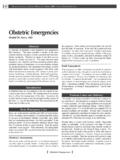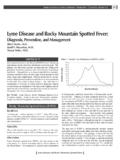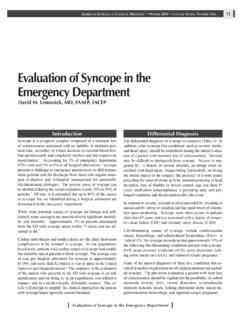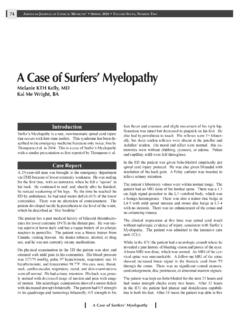Transcription of Attention Deficit Disorder (ADD) Attention Deficit ...
1 22 American Journal of Clinical Medicine Fall 2009 Volume Six, Number Four Attention Deficit Disorder (ADD). Attention Deficit Hyperactive Disorder (ADHD). Is it a product of our modern lifestyles? Presented at the 2009 AAPS Annual Scientific Meeting, San Diego, June 23, 2009. Nagui Hanna, MD. Abstract In the 1930s the Disorder was attributed to minimal brain dam- age or minimal brain dysfunction. Amphetamines were found ADHD is a complex Disorder of impairment of brain functions, to be efficacious in controlling symptoms.
2 In the 1950s it was which burdens our society with significant financial costs. Its called the Hyperactive Child Syndrome. 2. salient features are inattention, hyperactivity, and impulsivity. In many cases, it is accompanied by one or more serious psychi- Since then, the criteria for diagnosis have continually atric comorbidities. Criteria for its diagnosis have emerged over In 1968 the first criteria appeared in the DSM II (Diagnostic and the past four decades, resulting in better recognition and more Statistical Manual).
3 These were modified in 1980 in the DSM. widespread treatment. The current opinion estimates its preva- III3, then again in 1987 (DSM III R). Significant changes were lence in the USA to be 5 10% among school-aged children. introduced to the next editions, DSM IV in 19944 and DSM IV. It has strong heritability and genetic links, as well as environ- TR in mental predispositions and triggers. Although it mostly affects school-aged children, it is well known to affect preschoolers, Current literature suggests the presence of the following dis- youths, and even adults, with distinct manifestations and pro- tinctive subtypes of the Disorder : gression.
4 Treatment predominantly relies on prescribing stimu- Inattentive Subtype (pure ADD). lant medications (amphetamines), of which methylphenidate is the most widely used. Psychosocial therapy has an important Hyperactive Impulsive Subtype (classic ADHD). but less distinguished role in the management of the Disorder . Combined Subtype ADHD with Co-morbidities Attention Deficit Disorder ? The estimated annual cost of the Disorder in the US is about $31. Attention Deficit Disorder (ADD) or Attention Deficit Hyperac- billion, divided as follows.
5 Tive Disorder (ADHD) is a complex syndrome of impairments in Treatment for ADHD $ Billion developmental unfolding of the unconscious self-management system of the brain that affects significant numbers of children, Other healthcare cost for $ Billion adolescents, and adults, and often can be treated effectively Healthcare costs to $ Billion with appropriate Work loss costs to $ Billion General Considerations Diagnostic Criteria The Disorder was first described in 1902 by a London pediatri- The patient has to demonstrate the following: cian, Dr.
6 George Still, who initially thought it was the result of a viral encephalitis. He described it as a moral defect in 1. Maladaptive symptoms inconsistent with developmental which the patient has inhibition of the will. He believed that level, persisting for at least six months, of either inatten- affected children had depressed mothers and alcoholic fathers. tion (6 criteria) or hyperactivity-impulsivity (6 criteria). Attention Deficit Disorder (ADD). Attention Deficit Hyperactive Disorder (ADHD). American Journal of Clinical Medicine Fall 2009 Volume Six, Number Four 23.
7 2. Some of these impairing symptoms were present before Statistical Prevalence the age of seven. In 1999 the US Surgeon on Mental Health stated that 3 5%. 3. Impairment is present in two or more settings ( , at of school-aged children had Since then, screening for school and at home). and diagnosing the Disorder has been enhanced. 4. Clear evidence of clinically significant impairment in so- In 2001, the National Institute of Mental Health (NIMH) stated cial, academic, or occupational functioning. that ADHD affects an estimated of youths between the ages of 9 and 17 years.
8 Also, in 2001, the Mayo Clinic studies 5. The symptoms are not better accounted for by another used a figure of , while the American Academy of Pediat- mental Disorder . rics reviewed epidemiologic studies showing prevalence rates Six or more of the following symptoms are needed to meet the in the range of 4 12%. criteria of inattention: In 2002, the CDC reported that approximately 7% ( mil- Often fails to give close Attention to details or makes care- lion) of children in the US between the ages of 6 and 11 years less mistakes in schoolwork, work, or other activities.
9 Had ADHD. Of these (784,000) had ADHD without a learning disability, and (839,000) had ADHD and a learn- Often has difficulty sustaining Attention in tasks or play ing disability. activities. A review of over 9000 studies and surveys between the years Often does not seem to listen when spoken to directly. 1978 and 2005 estimated a pooled prevalence rate of Often does not follow through on instructions and fails to Another pooled estimate of 71 studies between 1997 and 2007. finish schoolwork, chores, or duties in the workplace.
10 Found the prevalence to vary between 27%. Most of this variability was accounted for by the different methods of sur- Often has difficulty organizing tasks and activities. vey and diagnosis. Often avoids, dislikes, or is reluctant to engage in tasks The currently accepted rate is about 5 10%. Boys are 4. that require sustained mental effort. times more likely to have the illness than girls. The Disorder Often loses things necessary for tasks or activities. is found in all cultures; and is known to persist into adulthood.










